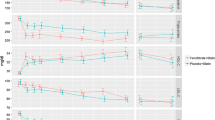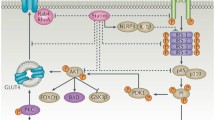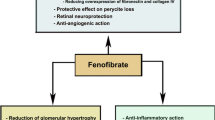Abstract
Introduction
The Fenofibrate Intervention and Event Lowering in Diabetes (FIELD) Study investigated the effect of fenofibrate treatment in 9,795 patients with type 2 diabetes.
Results and discussion
Reduction in major coronary events (the primary endpoint) and total cardiovascular disease (CVD) events (the secondary endpoint) was similar (relative risk reduction 11%), but only significant for total CVD events (p = 0.035). The benefit of fenofibrate treatment was greater in patients with mixed dyslipidaemia, especially in those with triglycerides >2.3 mmol/L and low plasma levels of high-density lipoprotein cholesterol (relative risk reduction 27%, p = 0.005). There were also microvascular benefits associated with fenofibrate treatment, specifically reduction in the rate of laser therapy for retinopathy (by 30%, p < 0.001), non-traumatic amputation (by 38%, p = 0.011) and progression of albuminuria (p < 0.002). Fenofibrate was generally well tolerated alone or in combination with a statin.
Conclusions
Overall, the FIELD study data support the use of fenofibrate for CVD prevention in diabetes, ideally in patients without prior macrovascular or microvascular complications. Fenofibrate may also have a role as a preventive treatment for diabetic retinopathy. Addition of fenofibrate to statin therapy may a logical progression from the FIELD study data, although the efficacy and tolerability of this approach needs to be evaluated in prospective outcome studies.

Similar content being viewed by others
References
Alberti KGMM, Zimmet P, Shaw J. International Diabetes Federation: a consensus on type 2 diabetes prevention. Diabet Med. 2007;24:451–63.
Stamler J, Vaccaro O, Neaton JD, et al. Diabetes, other risk factors, and 12-yr cardiovascular mortality for men screened in the Multiple Risk Factor Intervention Trial. Diabetes Care. 1993;16:434–44.
Miettinen H, Lehto S, Salomaa V, et al. Impact of diabetes on mortality after the first myocardial infarction. The FINMONICA Myocardial Infarction Register Study Group. Diabetes Care. 1998;21:69–75.
Huxley R, Barzi F, Woodward M. Excess risk of fatal coronary heart disease associated with diabetes in men and women: meta-analysis of 37 prospective cohort studies. BMJ. 2006;332:73–8.
Isomaa B, Almgren P, Tuomi T, et al. Cardiovascular morbidity and mortality associated with the metabolic syndrome. Diabetes Care. 2001;24:683–9.
Chiquette E, Chilton R. Cardiovascular disease: much more aggressive in patients with type 2 diabetes. Curr Atheroscler Rep. 2002;4:134–42.
Lipscombe LL, Hux JE. Trends in diabetes prevalence, incidence, and mortality in Ontario, Canada 1995-2005: a population-based study. Lancet. 2007;369:750–6.
Gregg EW, Gu Q, Cheng YJ, et al. Mortality trends in men and women with diabetes, 1971-2000. Ann Intern Med. 2007;147:149–55.
Hoerger TJ, Segel JE, Gregg EW, Saaddine JB. Is glycemic control improving in U.S. adults? Diabetes Care. 2008;31:81–6.
Imperatore G, Cadwell BL, Geiss L, et al. Thirty-year trends in cardiovascular risk factor levels among US adults with diabetes: National Health and Nutrition Examination Surveys, 1971–2000. Am J Epidemiol. 2004;160:531–9.
Fox CS, Coady S, Sorlie PD, et al. Increasing cardiovascular disease burden due to diabetes mellitus The Framingham Heart Study. Circulation. 2007;115:1544–50.
The United States Renal Data System. USRDS Annual Data Report. Bethesda, National Institutes of Health. National Institute of Diabetes and Digestive and Kidney Diseases, 2006. Available from http://www.usrds.org/atlas.htm. Accessed 28 Jan 2008.
American Diabetes Association. Standards of medical care in diabetes—2008. Diabetes Care 2008;31(suppl):S12–54.
Ryden L, Standl E, Bartnik M, Task Force on Diabetes and Cardiovascular Diseases of the European Society of Cardiology (ESC) and of the European Association for the Study of Diabetes (EASD), et al. Guidelines on diabetes, pre-diabetes, and cardiovascular disease: executive summary. Eur Heart J 2007;28:88–136.
National Cholesterol Education Program (NCEP) Expert Panel on Detection. Evaluation, and treatment of high blood cholesterol in adults. Third Report of the National Cholesterol Education Program (NCEP) Expert Panel on Detection, Evaluation, and Treatment of High Blood Cholesterol in Adults (Adult Treatment Panel III). Final report. Circulation 2002;106:3143–421.
Buse JB, Ginsberg HN, Bakris GL, et al. Primary prevention of cardiovascular diseases in people with diabetes mellitus. A Scientific Statement from the American Heart Association and the American Diabetes Association. Circulation. 2007;115:114–26.
UK Prospective Diabetes Study (UKPDS) Group. Intensive blood-glucose control with sulphonylureas or insulin compared with conventional treatment and risk of complications in patients with type 2 diabetes (UKPDS 33). Lancet 1998;352:837–53.
UKPDS report number 38. Tight blood pressure control and risk of macrovascular and microvascular complications in type 2 diabetes. BMJ 1998;317:703–13.
Packard CJ. Triacylglycerol-rich lipoproteins and the generation of small, dense low-density lipoprotein. Biochem Soc Trans. 2003;31:1066–9.
Sacks FM, Campos H. Low-density lipoprotein size and cardiovascular disease: a reappraisal. J Clin Endocrinol Metab. 2003;88:4525–32.
Cholesterol Treatment Trialist’s (CTT) Collaborators. Efficacy of cholesterol-lowering therapy in 18 686 people with diabetes in 14 randomised trials of statins: a meta-analysis. Lancet 2008;371:117–25.
Baigent C, Keech A, Kearney PM, et al. Efficacy and safety of cholesterol-lowering treatment: prospective meta-analysis of data from 90 056 participants in 14 randomised trials of statins. Lancet. 2005;366:1267–78.
Shepherd J, Barter P, Carmena R, et al. Effect of lowering LDL cholesterol substantially below currently recommended levels in patients with coronary heart disease and diabetes. The Treating to New Targets (TNT) study. Diabetes Care. 2006;29:1220–6.
Deedwania P, Barter P, Carmena R, et al. Reduction of low-density lipoprotein cholesterol in patients with coronary heart disease and metabolic syndrome: analysis of the Treating to New Targets Study. Lancet. 2006;368:919–28.
Birjmohun RS, Hutten BA, Kastelein JJP, et al. Efficacy and safety of high-density lipoprotein cholesterol-increasing compounds. A meta-analysis of randomized controlled trials. J Am Coll Cardiol. 2005;45:185–97.
Chapman MJ. Fibrates in 2003: therapeutic action in atherogenic dyslipidaemia and future perspectives. Atherosclerosis. 2003;171:1–13.
Rubins HB, Robins SJ, Collins D, et al. Diabetes, plasma insulin, and cardiovascular disease. Subgroup analysis from the Department of Veterans Affairs High-density Lipoprotein Intervention Trial (VA-HIT). Arch Intern Med 2002;162:2597–604.
Effect of fenofibrate on progression of coronary-artery disease in type 2 diabetes; the Diabetes Atherosclerosis Intervention Study, a randomised study. Lancet. 2001;357:905–10.
Keech A, Simes RJ, Barter P, FIELD Study Investigators, et al. Effect of long-term fenofibrate therapy on cardiovascular events in 9795 people with type 2 diabetes mellitus (the FIELD Study): randomised controlled trial. Lancet 2005;366:1849–61.
Keech A, Simes J, Barter P, et al. Correction to the FIELD Study report. Lancet. 2006;368:1415. (letter).
Heart Protection Study Collaborative Group. MRC/BHF Heart Protection Study of cholesterol-lowering with simvastatin in 5963 people with diabetes: a randomised placebo-controlled trial. Lancet 2003;361:2005–16.
Scott R, O’Brien R, Fulcher G, et al. The effects of fenofibrate treatment on cardiovascular disease risk in 9795 people with type 2 diabetes and various components of the metabolic syndrome: the FIELD study. Diabetes Care 2008; published online November 4, 2008.
Tenenbaum A, Motro M, Fisman EZ, et al. Bezafibrate for the secondary prevention of myocardial infarction in patients with metabolic syndrome. Arch Intern Med. 2005;165:1154–60.
Burgess D, Hunt D, Li LP, et al. Effects of fenofibrate on silent myocardial infarction, hospitalization for acute coronary syndromes and amputation in type 2 diabetes: the Fenofibrate Intervention and Event Lowering in Diabetes (FIELD) Study. Circulation. 2007;116:II_838. (Abstract 3691).
Keech AC, Mitchell P, Summanen PA, et al. Effect of fenofibrate on the need for laser treatment for diabetic retinopathy (FIELD Study): a randomised controlled trial. Lancet. 2007;370:1687–97.
Ansquer JC, Foucher C, Rattier S, et al. Fenofibrate reduces progression to microalbuminuria over 3 years in a placebo-controlled study in type 2 diabetes: results from the Diabetes Atherosclerosis Intervention Study (DAIS). Am J Kidney Dis. 2005;45:485–93.
Davidson MH, Armani A, McKenney JM, Jacobson TA. Safety considerations with fibrate therapy. Am J Cardiol 2007;99:3C–18C.
Alsheikh-Ali AA, Kuvin JT, Karas RH. Risk of adverse events with fibrates. Am J Cardiol. 2004;94:935–8.
Jones PH, Davidson MH. Reporting rate of rhabdomyolysis with fenofibrate + statin versus gemfibrozil + any statin. Am J Cardiol. 2005;95:120–2.
Prueksaritanont T, Tang C, Qiu Y, et al. Effects of fibrates on metabolism of statins in human hepatocytes. Drug Metab Dispos. 2002;30:1280–7.
Corsini A, Bellosta S, Davidson MH. Pharmacokinetic interactions between statins and fibrates. Am J Cardiol 2005;96:44K–9K.
ACCORD Study Group. Action to Control Cardiovascular Risk in Diabetes trial: design and methods. Am J Cardiol 2007;99:21i–33i.
Acknowledgements
The preparation of this manuscript was assisted by an unrestricted educational grant from ABBOTT Laboratories. The author acknowledges editorial assistance provided by Jane Stock PhD.
Disclosures
The author has received funding for clinical trials from Merck, Pfizer, Astra-Zeneca, and Takeda. He is a lecturer or advisor for Merck, Schering-Plough, Astra-Zeneca, Glaxo-SmithKline, and Abbott.
Author information
Authors and Affiliations
Corresponding author
Rights and permissions
About this article
Cite this article
Fazio, S. More Clinical Lessons from the FIELD Study. Cardiovasc Drugs Ther 23, 235–241 (2009). https://doi.org/10.1007/s10557-008-6160-5
Published:
Issue Date:
DOI: https://doi.org/10.1007/s10557-008-6160-5




